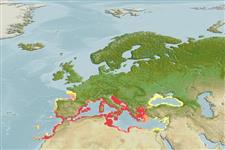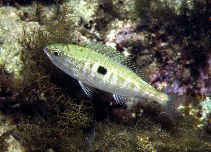Add your observation in Fish Watcher
| Native range | All suitable habitat | Point map | Year 2050 |

|
| This map was computer-generated and has not yet been reviewed. |
| Spicara maena AquaMaps Data sources: GBIF OBIS |
Upload your photos and videos
Pictures | Videos | Google imageSpicara maena
Picture by Patzner, R.
Pictures | Videos | Google imageSpicara maena
Picture by Patzner, R.
Croatia country information
Common names:
Cipavica, Gavorica, Gira oštrulja
Occurrence: native
Salinity: marine
Abundance: | Ref:
Importance: | Ref:
Aquaculture: | Ref:
Regulations: | Ref:
Uses: no uses
Comments: Species maena and flexuosa observed to have some difference, with the former more blue and can grow bigger, it spawns in September on poseidonia and observed to be fighthing for mates; the latter spawns in winter at depts of 30 -50 meters on different bottom (lignja@submania.hr, pers. comm. 09/2006).
National Checklist:
Country Information: https://www.cia.gov/library/publications/resources/the-world-factbook/geos/hr.html
National Fisheries Authority:
Occurrences: Occurrences Point map
Main Ref: Bauchot, M.-L., 1987
National Database:
Occurrence: native
Salinity: marine
Abundance: | Ref:
Importance: | Ref:
Aquaculture: | Ref:
Regulations: | Ref:
Uses: no uses
Comments: Species maena and flexuosa observed to have some difference, with the former more blue and can grow bigger, it spawns in September on poseidonia and observed to be fighthing for mates; the latter spawns in winter at depts of 30 -50 meters on different bottom (lignja@submania.hr, pers. comm. 09/2006).
National Checklist:
Country Information: https://www.cia.gov/library/publications/resources/the-world-factbook/geos/hr.html
National Fisheries Authority:
Occurrences: Occurrences Point map
Main Ref: Bauchot, M.-L., 1987
National Database:
Common names from other countries
Classification / Names Nombres comunes | Sinónimos | Catalog of Fishes(Género, Especie) | ITIS | CoL | WoRMS | Cloffa
> Eupercaria/misc (Various families in series Eupercaria) > Sparidae (Porgies)
Etymology: Spicara: Latin, spicare = furnished with spike (Ref. 45335).
More on author: Linnaeus.
Etymology: Spicara: Latin, spicare = furnished with spike (Ref. 45335).
More on author: Linnaeus.
Issue
Spicara flexuosa Rafinesque, 1810 is a valid species (Ref. 124120). Species page to be created.
Environment: milieu / climate zone / depth range / distribution range Ecología
marino; rango de profundidad 30 - 130 m (Ref. 7349). Subtropical; 47°N - 28°N, 19°W - 42°E
Distribución Países | Áreas FAO | Ecosistemas | Ocurrencias, apariciones | Point map | Introducciones | Faunafri
Eastern Atlantic: Portugal, Morocco, and Canary Islands including the Mediterranean and Black Sea.
Length at first maturity / Tamaño / Peso / Age
Maturity: Lm 11.5 range ? - ? cm
Max length : 25.0 cm SL macho / no sexado; (Ref. 6518); 21.0 cm SL (female); peso máximo publicado: 160.00 g (Ref. 131232)
Max length : 25.0 cm SL macho / no sexado; (Ref. 6518); 21.0 cm SL (female); peso máximo publicado: 160.00 g (Ref. 131232)
Adults are found in the neritic zone, commonly over Posidonia beds and on sand, muddy and rock bottoms down to about 100 m (Ref. 6518, 124120). They are distributed at depths of 30m to 90m (Ref. 56124). Feed on zooplankton. Are protogynous hermaphrodites. A demersal spawner (Ref. 124120).
Life cycle and mating behavior Madurez | Reproducción | Puesta | Huevos | Fecundidad | Larva
Sex reversal occurs at lengths over 10.9 cm TL in the northeastern Mediterranean (Ref. 93202). Also Ref. 103751.
Main reference
Upload your references | Referencias | Coordinador | Colaboradores
Heemstra, P.C., 1990. Centracanthidae. p. 768-772. In J.C. Quero, J.C. Hureau, C. Karrer, A. Post and L. Saldanha (eds.) Check-list of the fishes of the eastern tropical Atlantic (CLOFETA). JNICT, Lisbon; SEI, Paris; and UNESCO, Paris. Vol. 2. (Ref. 7349)
IUCN Red List Status (Ref. 130435: Version 2024-2)
Least Concern (LC) ; Date assessed: 22 August 2009
Threat to humans
Harmless
Human uses
Pesquerías: escaso valor comercial; pesca deportiva: si
FAO(pesquerías: producción; publication : search) | FishSource | Sea Around Us
Más información
Trophic ecology
componentes alimenticios
Composición de la dieta
consumo de alimento
Food rations
Despredadores
componentes alimenticios
Composición de la dieta
consumo de alimento
Food rations
Despredadores
Population dynamics
Coeficiente del crecimiento para
Max. ages / sizes
Length-weight rel.
Length-length rel.
Length-frequencies
Mass conversion
Reclutamiento
Abundancia
Coeficiente del crecimiento para
Max. ages / sizes
Length-weight rel.
Length-length rel.
Length-frequencies
Mass conversion
Reclutamiento
Abundancia
Life cycle
Reproducción
Madurez
Fecundidad
Puesta
Spawning aggregations
Huevos
Egg development
Larva
Dinámica larvaria
Reproducción
Madurez
Fecundidad
Puesta
Spawning aggregations
Huevos
Egg development
Larva
Dinámica larvaria
Physiology
Body composition
Nutrients
Consumo del oxígeno
Tipo de natación
Velocidad de natación
Visual pigments
Fish sound
Diseases & Parasites
Toxicity (LC50s)
Body composition
Nutrients
Consumo del oxígeno
Tipo de natación
Velocidad de natación
Visual pigments
Fish sound
Diseases & Parasites
Toxicity (LC50s)
Human related
Aquaculture systems
Perfiles de acuicultura
Razas
Ciguatera cases
Stamps, coins, misc.
Aquaculture systems
Perfiles de acuicultura
Razas
Ciguatera cases
Stamps, coins, misc.
Herramientas
Bio-Quiz | E-book | Guía de campo | Asistente para frecuencias de tallas | Herramienta de ciclo de vida | Mapa de puntos | Classification Tree
| Catch-MSY |
Special reports
Download XML
Fuentes de Internet
Aquatic Commons | BHL | Cloffa | BOLDSystems | Websites from users | Check FishWatcher | CISTI | Catalog of Fishes(Género, Especie) | DiscoverLife | DORIS | ECOTOX | Faunafri | Fishtrace | GenBank(genome, nucleotide) | GloBI | GOBASE | | Google Books | Google Scholar | Google | IGFA World Record | MitoFish | Bases de datos nacionales | Otolith Atlas of Taiwan Fishes | Acuarios públicos | PubMed | Reef Life Survey | Scirus | SeaLifeBase | Árbol de la vida | Wikipedia(Go, búsqueda) | World Records Freshwater Fishing | Expediente Zoológico
Estimates based on models
Preferred temperature (Ref. 115969): 13 - 18.1, mean 14.5 (based on 87 cells).
Phylogenetic diversity index (Ref. 82804): PD50 = 0.5039 [Uniqueness, from 0.5 = low to 2.0 = high].
Bayesian length-weight: a=0.01096 (0.01001 - 0.01201), b=3.02 (2.99 - 3.05), in cm Total Length, based on LWR estimates for this species (Ref. 93245).
Nivel trófico (Ref. 69278): 4.2 ±0.6 se; based on diet studies.
Resiliencia (Ref. 120179): Medio, población duplicada en un tiempo mínimo de 1.4-4.4 años (K=0.24; tmax=5).
Prior r = 1.01, 95% CL = 0.66 - 1.51, Based on 1 data-limited stock assessment.
Fishing Vulnerability (Ref. 59153): Moderate vulnerability (36 of 100).
Climate Vulnerability (Ref. 125649): Moderate vulnerability (42 of 100).




